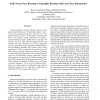Free Online Productivity Tools
i2Speak
i2Symbol
i2OCR
iTex2Img
iWeb2Print
iWeb2Shot
i2Type
iPdf2Split
iPdf2Merge
i2Bopomofo
i2Arabic
i2Style
i2Image
i2PDF
iLatex2Rtf
Sci2ools
110
Voted
ICNP
2005
IEEE
2005
IEEE
Path Vector Face Routing: Geographic Routing with Local Face Information
Existing geographic routing algorithms depend on the planarization of the network connectivity graph for correctness, and the planarization process gives rise to a welldefined notion of “faces”. In this paper, we demonstrate that we can improve routing performance by storing a small amount of local face information at each node. We present a protocol, Path Vector Exchange (PVEX), that maintains local face information at each node efficiently, and a new geographic routing algorithm, Greedy Path Vector Face Routing (GPVFR), that achieves better routing performance in terms of both path stretch and hop stretch than existing geographic routing algorithms by exploiting available local face information. Our simulations demonstrate that GPVFR/PVEX achieves significantly reduced path and hop stretch than Greedy Perimeter Stateless Routing (GPSR) and somewhat better performance than Greedy Other Adaptive Face Routing (GOAFR+) over a wide range of network topologies. The cost of this imp...
Related Content
| Added | 25 Jun 2010 |
| Updated | 25 Jun 2010 |
| Type | Conference |
| Year | 2005 |
| Where | ICNP |
| Authors | Ben Leong, Sayan Mitra, Barbara Liskov |
Comments (0)

